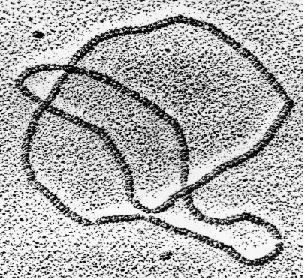
|
|
N. Cozzarelli |
In order to fight the action of viruses which cause so many diseases, biologists have recently started using the theory of knots, once thought of as a totally pure branch of mathematics. One of the goals of this theory is to classify all types of knots. Of course, one can easily differentiate visually the simple knots, but this task quickly becomes difficult with more complicated knots.
Mathematicians have developed many methods for distinguishing knots, that is to determine if two diagrams of knots are or are not really the same knot. Find out more by visiting the Knots section. But what is the connection with viruses? It is that all the characteristics and instructions of a living being are coded in the DNA, these very long molecules folded in on themselves in the nuclei of cells. For actual electron micrographs visit the DNA section of Knots.
Viruses attack cells in order to alter the DNA inside them. To do this, they bring closer certain parts of the DNA, then cut them and stick them back together differently, in such a way that the molecule of DNA is transformed into a knot. One of the essential aspects of the struggle against viruses is to recognize the signature of different viruses by their effects on the DNA. One can characterize these effects by the type of knot which results from the action of the virus. But then, it is necessary to be able to recognize the knot in question if one wants to find out which virus it is. It is here that the work of mathematicians enters into play.
© Mathematics and Knots, U.C.N.W.,Bangor, 1996 - 2002
This material may be used freely for educational, artistic and
scientific purposes, but may not be used for commercial purposes,
for profit or in texts without the permission of the publishers.